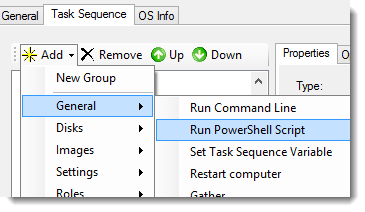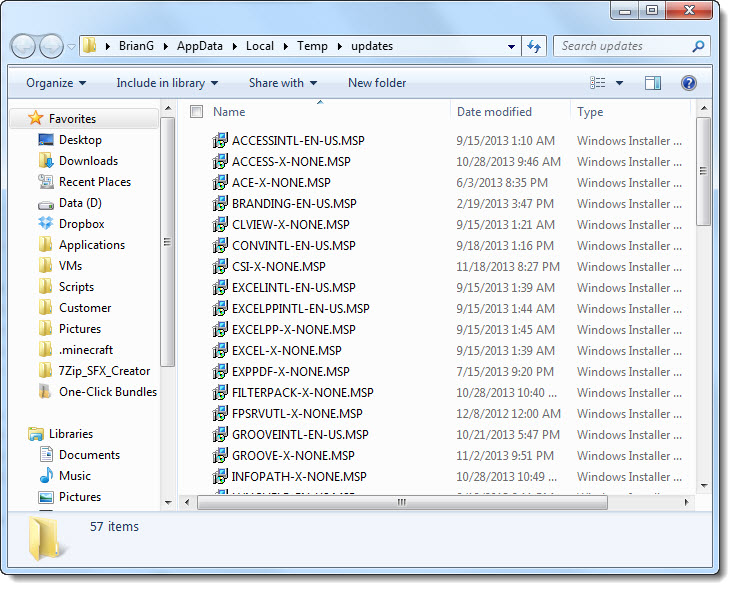The VBScript sample from Microsoft was a start, but here were the major limitations:
- Only meant to be used from within the “Scripts” folder, which is not useful when attempting to install applications.
- Does not include examples of actually using the ZTIUtility.vbs functions.
Template pulled from http://gallery.technet.microsoft.com/scriptcenter/84d18835-300a-42e3-b0e7-29cb7fc5aafc.
* Thanks Mr. Barnes!
GitHub Link: https://github.com/brianfgonzalez/Scripts/blob/master/Z-MyMDTTemplate.wsf
<job id="Z-Sample">
<script language="VBScript" src="..\..\Scripts\ZTIUtility.vbs"/>
<script language="VBScript">
' //***************************************************************************
' // ***** Script Header *****
' //
' // Solution: Solution Accelerator for Microsoft Deployment
' // File: Z-MyMDTTemplate.wsf
' //
' // Purpose: Template
' //
' // Usage: cscript Z-MyMDTTemplate.wsf [/debug:true]
' //
' // Customer Build Version: 1.0.0
' // Customer History:
' //
' // ***** End Header *****
' //***************************************************************************
'//----------------------------------------------------------------------------
'//
'// Global constant and variable declarations
'//
'//----------------------------------------------------------------------------
Option Explicit
Dim iRetVal
'//----------------------------------------------------------------------------
'// End declarations
'//----------------------------------------------------------------------------
'//----------------------------------------------------------------------------
'// Main routine
'//----------------------------------------------------------------------------
On Error Resume Next
iRetVal = ZTIProcess
ProcessResults iRetVal
On Error Goto 0
'//---------------------------------------------------------------------------
'//
'// Function: ZTIProcess()
'//
'// Input: None
'//
'// Return: Success - 0
'// Failure - non-zero
'//
'// Purpose: Perform main ZTI processing
'//
'//---------------------------------------------------------------------------
Function ZTIProcess()
iRetVal = Success
ZTIProcess = iRetval
'!!!!!!!!!!! INSERT YOUR CODE HERE !!!!!!!!!!!!
'Set a variable example
'oEnvironment.Item("OSDComputerName") = "PC-01"
'Read a variable example
'If oEnvironment.Exists("_SMSTSORGNAME") then
' Wscript.Echo "The Property Value = " & oEnvironment.Item("_SMSTSORGNAME")
'Else
' Wscript.Echo "The Property Value is not set!"
'End if
'Check if a variable is Null or Empty
'If oEnvironment.isNullOrEmpty("_SMSTSORGNAME") then
' Wscript.Echo "The Property Value = " & oEnvironment.Item("_SMSTSORGNAME")
'Else
' Wscript.Echo "The Property Value is not set!"
'End if
'Other oEnvironment methods
'oEnvironment.Substitute(sVal)
'Given a string, will expand any variables and/or functions within that string.
'oEnvironment.ListItem(sName)
'Read/Write a variable of type array to a persistent store.
'Create a Log file with the name of the script file in the MININT\SMSOSD\OSDLOGS\ directory.
'oLogging.CreateEntry "Logging: Beginning logging process", LogTypeInfo
'wscript.echo "Hello world"
'oLogging.CreateEntry "This is an Information Log Entry", LogTypeInfo
'oLogging.CreateEntry "This is a Warning Log Entry", LogTypeWarning
'oLogging.CreateEntry "This is an Error Log Entry", LogTypeError
'oLogging.CreateEntry "Logging: End logging process", LogTypeInfo
'oLogging.ReportFailure (sMessage,iError)
'Used to perform a structured exit if an unrecoverable error is detected.
'oLogging.CreateEvent(iEventID, iType, sMessage, arrParms)
'Write a message to the log file, and post the event to a defined server.
'Delete a file
'Dim sTargetFile
'sTargetFile = "C:\test.txt"
'oFileHandling.DeleteFile sTargetFile
'Move a file
'Dim sFile, sDest
'sFile = "C:\Folder1\test.txt"
'sDest = "C:\Folder2\"
'oFileHandling.MoveFile sFile, sDest
'Copy a file
'Dim sFile, sDest, bOverwrite
'sFile = "C:\Folder1\test.txt"
'sDest = "C:\Folder2\"
'bOverwrite = True
'oFileHandling.CopyFile sFile, sDest, bOverwrite
'Copy a folder
'Dim sSource, sDest, bOverwrite
'sSource = "C:\Folder1"
'sDest = "C:\Folder2"
'bOverwrite = True
'oFileHandling.CopyFolder sSource, sDest, bOverwrite
'Move a folder
'Dim sSource, sDest
'sSource = "C:\Folder1"
'sDest = "C:\Folder2\"
'oFileHandling.MoveFolder sSource, sDest
'Delete a folder incl. sub-folders
'Dim sPath
'sPath = "C:\Folder1"
'oFileHandling.RemoveFolder sPath
'Read a registry key
'Dim sRegValue, sRegKey
'sRegKey = "HKEY_LOCAL_MACHINE\SOFTWARE\Microsoft\Internet Explorer\Version"
'sRegValue=oUtility.regread(sregkey)
'oLogging.CreateEntry "IE Version is " & sRegValue, LogTypeInfo
'Write a registry key
'Dim sRegValue, sRegKey, sNewRegValue
'sRegKey = "HKEY_LOCAL_MACHINE\SOFTWARE\Microsoft\Windows\CurrentVersion\Run\New Program"
'sNewRegValue = "C:\Windows\Notepad.exe"
'sRegValue=oUtility.regWrite(sregkey, sNewRegValue)
'Pre-defined objects
'oFSO – File System Object
'oShell – Wscript Shell object
'oEnv - Process Environment object
'oNetwork - WScript Network object
'Returns the full path of the script into the sScript variable
'Dim sScriptName, sScript
'sScriptName = "Set-Supervisor.wsf"
'iRetVal = oUtility.FindFile(sScriptName, sScript)
'If iRetVal <> Success then
' oLogging.CreateEntry "Unable to locate script " & sScriptName, LogTypeError
' Exit Function
'End if
'Script Directory and Name variables
'oUtility.ScriptName
'oUtility.ScriptDir
'oUtility.LogPath
'Sleep (Timeout) the script "safely"
'oUtility.SafeSleep(miliSeconds)
'sFile = oUtility.ScriptDir & "\WMI Provider GUI InstallShield Package 1.00L18.exe"
'If not oFSO.FileExists(sFile) then
' oLogging.CreateEntry "Install Panasonic BIOS Provider: " & sFile & " was not found, unable to install.", LogTypeError
' ZTIProcess = Failure
' Exit Function
'End if
'sCmd = sFile & " -s -f1""" & _
' oUtility.ScriptDir & "\noui.iss"" -f2""" & _
' oUtility.LogPath & "\PanasonicBIOSProvider.log"""
'oLogging.CreateEntry "Running: " & sCmd, LogTypeInfo
'iRetVal = oUtility.RunWithHeartbeat(sCmd)
'If (iRetVal = 0) or (iRetVal = 3010) then
' ZTIProcess = Success
'Else
' ZTIProcess = Failure
'End If
'oLogging.CreateEntry "Install Panasonic BIOS Provider: Return code from command = " & iRetVal, LogTypeInfo
'oLogging.CreateEntry "Install Panasonic BIOS Provider: Finished installation", LogTypeInfo
'Pull OS Version from Win32_OperatingSystem WMI
'Set oOperatingSystems = objWMI.ExecQuery ("Select * from Win32_OperatingSystem")
'For Each oTmp in oOperatingSystems
' sOSCurrentVersion = oTmp.Version
'Next
'Run console command and hide window
'RunWithConsoleLoggingAndHidden(sCmd)
'Trim all white space from variable
'oEnvironment.Item("_SMSTSORGNAME") = oUtility.TrimAllWS(oEnvironment.Item("_SMSTSORGNAME"))
'Get random number/guid
'oUtility.GenerateRandomGUID
'Other File/Folder methods
'oFileHandling.NormalizePath
'oFileHandling.GetTempFolder
'oFileHandling.GetTempFile
'oFileHandling.GetTempFileEx("FileExtension")
'oFileHandling.GetWindowsFolder
'Check if the file is newer than a specified version
'Dim sFileName, iMinVersion
'sFileName = oUtility.ScriptDir & "\MyInstall.msi"
'iMinVersion = 1.3
'If oUtility.CheckFileVersion(sFileName, iMinVersion) Then
' Wscript.echo "File is new enough.."
'End If
'Regular Expression match
'For Each Match in oRegEx.GetRegExMatchesFromFile( "\[([^\]]*)\]","c:\boot.ini" )
' Wscript.echo "Match: " & Match
'Next
End Function
</script>
</job>
</script>
</job>
/BG


